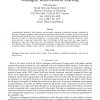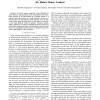132 search results - page 6 / 27 » Generalization in Reinforcement Learning: Safely Approximati... |
IWANN
1999
Springer
13 years 11 months ago
1999
Springer
To avoid the curse of dimensionality, function approximators are used in reinforcement learning to learn value functions for individual states. In order to make better use of comp...
IAT
2003
IEEE
14 years 12 days ago
2003
IEEE
A gradient-based method for both symmetric and asymmetric multiagent reinforcement learning is introduced in this paper. Symmetric multiagent reinforcement learning addresses the ...
ESANN
2007
13 years 8 months ago
2007
The eligibility trace is one of the most used mechanisms to speed up reinforcement learning. Earlier reported experiments seem to indicate that replacing eligibility traces would p...
CDC
2010
IEEE
13 years 2 months ago
2010
IEEE
Abstract-- We consider reinforcement learning, and in particular, the Q-learning algorithm in large state and action spaces. In order to cope with the size of the spaces, a functio...
ICRA
2007
IEEE
14 years 1 months ago
2007
IEEE
— The least squares approach works efficiently in value function approximation, given appropriate basis functions. Because of its smoothness, the Gaussian kernel is a popular an...


